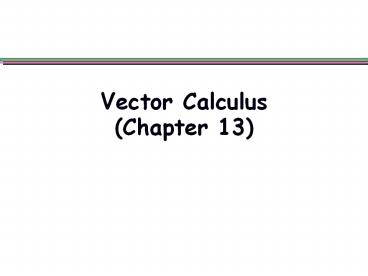Vector Calculus (Chapter 13) PowerPoint PPT Presentation
Title: Vector Calculus (Chapter 13)
1
Vector Calculus(Chapter 13)
2
Vector Calculus
Chapter
13
13.2-13.3
13.4
13.1
ScalarFields, 2D VectorFields
Gradient VectorFields
LineIntegrals
GreensTheorem
3
F(x,y)ltP(x,y),Q(x,y)gt
4
Scalar Fields and Vector Fields
- The simplest possible physical field is the
scalar field. - It represents a function depending on the
position in space. A scalar field is
characterized at each point in space by a single
number. - Examples of scalar fields
- temperature, gravitational potential,
electrostatic potential (voltage)
5
Scalar Fields Visualization of zV(x,y)
- Scalar potential function for a dipole V(x,y)
6
(No Transcript)
7
Maple commands
8
Scalar Fields and Equipotential Lines
- The level curves or contours of the function
zV(x,y) are the equipotential lines of the
scalar potential field V(x,y)
9
The Gradient defines a Vector Field (the force
field)
10
Arrow Diagram for Vector Field
11
Direction Field (magnitude1)
12
(No Transcript)
13
Equipotential surfaces are orthogonal to the
electric force field
Notice the force field is directed towards
placeswhere the potential V is lower, e.g.,
where thecharge is negative - at(0.25,0).But
mathematically,the gradient points in the
opposite direction (greatest ascent) which is
why f-Vand Fgrad(f)grad(-V)
14
2D vector field visualization of the flow field
past an air foil using arrows
PowerShow.com is a leading presentation sharing website. It has millions of presentations already uploaded and available with 1,000s more being uploaded by its users every day. Whatever your area of interest, here you’ll be able to find and view presentations you’ll love and possibly download. And, best of all, it is completely free and easy to use.
You might even have a presentation you’d like to share with others. If so, just upload it to PowerShow.com. We’ll convert it to an HTML5 slideshow that includes all the media types you’ve already added: audio, video, music, pictures, animations and transition effects. Then you can share it with your target audience as well as PowerShow.com’s millions of monthly visitors. And, again, it’s all free.
About the Developers
PowerShow.com is brought to you by CrystalGraphics, the award-winning developer and market-leading publisher of rich-media enhancement products for presentations. Our product offerings include millions of PowerPoint templates, diagrams, animated 3D characters and more.

